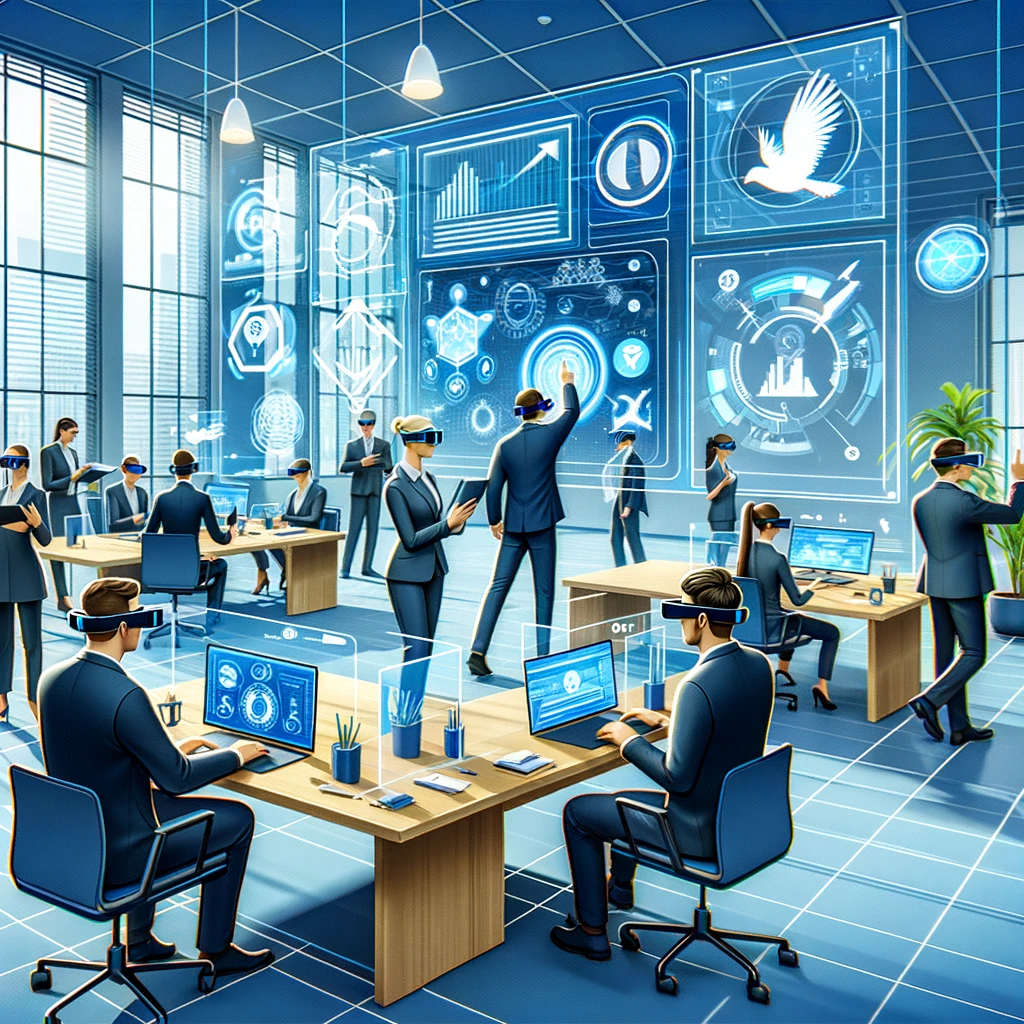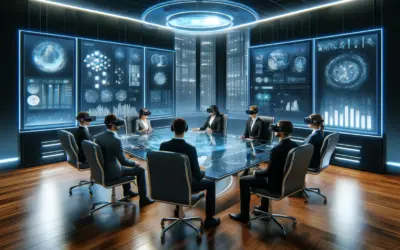Augmented Reality (AR) is an innovative technology that layers computer-generated enhancements atop an existing reality in order to make it more meaningful through the ability to interact with it. AR is developed into apps and used on mobile devices to blend digital components into the real world in such a way that they enhance one another, but can also be clearly distinguished. AR technology is becoming increasingly popular, finding its way into various sectors, with corporate training being one of the most significant beneficiaries.
What is Augmented Reality?
At its core, Augmented Reality is about overlaying digital information onto the physical environment. Unlike Virtual Reality (VR), which creates a completely artificial environment, AR uses the existing environment and overlays new information on top of it. This feature is particularly useful in corporate training, as it allows employees to receive real-time information and feedback while interacting with real-world scenarios. Applications can range from simple text notifications about machinery to complex 3D models that can be manipulated and explored by the user.
AR’s Impact on Corporate Training
Corporate training programs greatly benefit from AR by making the learning process more engaging and interactive. AR provides learners with practical, hands-on experience and can simulate various scenarios for training purposes without the risks associated with real-world training. With AR, the information retention rates are augmented as well, given the interactive nature of the learning process.
- Enhanced Engagement: AR’s interactive elements often lead to higher engagement levels among trainees. This is crucial for learning and retaining new concepts, as engaged learners are more likely to absorb and recall information.
- Risk-Free Simulation: Industries such as healthcare, manufacturing, and construction, where mistakes can be costly or dangerous, particularly stand to benefit. AR enables employees to practice their skills in a controlled, virtual environment that closely mimics real-world conditions.
- Cost-Effective: While the initial investment in AR technology might be significant, it often saves money in the long run. Traditional training may require travel, physical materials, and can also be time-consuming. AR can condense training time and eliminate the need for physical resources.
Augmented Reality in corporate training is not just a passing trend. It’s a substantial shift in how training and development are approached. As the technology advances and becomes more accessible, its role in workplace learning is set to increase, offering more immersive, effective, and efficient ways to train employees. In a world that is continuously evolving, AR equips the workforce with the tools they need to adapt and excel in their respective fields.
By incorporating AR into their training strategies, companies are not just investing in new technology—they are investing in their most valuable asset: their employees. This commitment to innovative learning solutions can lead to improved performance, enhanced safety, and, ultimately, a robust competitive edge in the market.
The Benefits of Integrating Augmented Reality into Employee Training Programs
Augmented Reality (AR) technology has emerged as a transformative tool for various sectors, and its integration into employee training programs is revolutionizing the way organizations upskill their workforce. The application of AR in training brings a wealth of benefits that not only enhance the learning experience but also contribute to more effective knowledge retention and application in the workplace.
Increased Engagement and Interactivity
One of the most significant advantages of AR in training is the increase in engagement and interactivity it provides. Traditional training methods often struggle to maintain employee attention, but AR creates an immersive learning environment that captivates users. By overlaying digital information onto the real world, trainees can interact with virtual elements in a tangible way. This hands-on approach fosters a more dynamic and stimulating educational experience that encourages active participation.
Improved Knowledge Retention
The immersive nature of AR training not only captures the interest of learners but also enhances their ability to retain information. Studies have shown that we remember 90% of what we do, compared to just 10% of what we read. AR’s interactive sessions enable employees to practice and learn through experience, leading to better memory retention and understanding of complex concepts. Such experiential learning translates into employees who are better equipped to apply their knowledge in real-world scenarios.
Realistic Simulations and Safe Practice
- Safer Training Environment: AR allows employees to practice tasks in a controlled, virtual space where mistakes do not have real-world consequences. This is particularly valuable for roles that involve risk, such as machinery operation or handling hazardous materials. Trainees can repeatedly simulate scenarios until they’re proficient, ensuring they’re prepared for actual on-the-job tasks.
- Real-World Application: By simulating real-life situations, AR in training offers a bridge between theory and practice. Learners can interact with life-like simulations that closely resemble their work environment and tasks. This ensures that the skills they acquire are directly applicable to their jobs, which is more efficient and beneficial for both the employee and the organization.
Customized Learning Experiences
One size does not fit all when it comes to learning, and AR technology acknowledges this by offering tailored experiences to meet different learning styles and needs. Whether employees are visual, auditory, or kinesthetic learners, AR can cater to these preferences with its versatility. As a result, training sessions become more personal and effective. Furthermore, AR analytics allow trainers to track progress and adapt the training modules to address individual weaknesses, optimizing the learning process for each employee.
As the workforce continues to evolve, integrating AR into training programs may no longer be a futuristic concept but a necessary step in developing a skilled, efficient, and engaged workforce. Embracing the benefits that AR brings to education, companies can look forward to a significant return on investment in their employee training initiatives.
Case Studies: Successful Applications of Augmented Reality in Corporate Training
Augmented Reality (AR) technology is revolutionizing the way companies approach training and development. AR allows for interactive experiences that enhance learning and retention. In this blog post, we’ll explore real-world case studies where augmented reality has successfully been implemented in corporate training programs.
Enhancing Technical Skills Through AR Simulations
One notable case study involves a multinational aerospace company that used AR to train their assembly line workers. By overlaying digital information onto the physical work environment, AR provided step-by-step instructions, reducing the learning curve for complex tasks. The results were compelling; the company reported a drastic drop in errors and a significant improvement in assembly time. This reflective case highlights AR’s capability to streamline workflows and improve precision in technical training.
Boosting Sales Performance with AR-enabled Learning
In the competitive world of sales, a leading automotive brand harnessed the power of AR to equip their salesforce with detailed knowledge of car models. Through AR applications, sales professionals could showcase car features and customizations directly to the customer, creating an immersive and interactive sales experience. As a consequence, the brand saw an upsurge in customer engagement and sales conversion rates. This instance illustrates how AR elevates training, making it more applicable and engaging.
AR for Safety Training and Compliance
Safety is paramount in industries such as construction and manufacturing. A construction company seeking to improve safety protocols adopted AR to simulate hazardous scenarios in a controlled environment. Trainees could navigate virtual construction sites, practice emergency procedures, and identify safety violations without the associated risks of a real-life site. This innovative approach not only resulted in increased safety awareness but also a decrease in work-related accidents. The adoption of AR in safety training showcases its potential in creating effective real-world risk assessments and proactive learning cultures.
In conclusion, these case studies illuminate the profound impact that AR can have on corporate training. By fostering a dynamic, immersive, and interactive learning environment, AR technology is setting new benchmarks in the domain of corporate training and development. With real-world success stories from different industries, it’s evident that AR’s value in enhancing skills, boosting performance, and ensuring compliance is significant. As technology continues to evolve, we can expect to see even more innovative applications in the future.
Best Practices for Designing an Augmented Reality Training Program in the Workplace
Understanding the Scope and Objectives
When embarking on the journey to design an augmented reality (AR) training program in the workplace, it’s essential to understand the desired outcomes and operational scope. AR experiences must be tailored to enhance learning and performance while aligning with business objectives. Identify specific skills or processes that will benefit from visual and interactive learning. This ensures that your AR training is both relevant and impactful.
Identify Training Goals
Start by listing the skills or knowledge that employees should acquire. Discuss with team leaders and stakeholders to ensure these goals align with company targets. This approach fosters a program that is valuable for both the employees’ growth and the organization’s needs.
Assess Technical Limitations
Consider the technical capacity of your infrastructure to support AR. This includes evaluating devices available, network capabilities, and software requirements. Ensure that the technical groundwork is laid to facilitate a seamless AR training experience.
Creating Engaging Content and Interactions
Content is king in AR training programs. Use storytelling and gamification to capture attention and improve retention. Develop scenarios that mimic real-life challenges encouraging active participation. Ensure that the content provided through AR is interactive and intuitive, offering immediate feedback to facilitate learning and engagement.
Designing for User Experience
AR training should occur with minimal interruptions and user interface complications. Each interaction should feel natural and contribute directly to the learning process. For this, employ user experience (UX) design practices that cater to varied learning styles and technological proficiencies.
Incorporating Immediate Feedback
Immediate feedback is a powerful tool in learning. Design your AR program to provide responses to actions swiftly, helping learners correct mistakes and understand concepts promptly. This builds confidence and retains engagement throughout the training.
Integrating with Existing Training Modules
Designing an AR training program does not mean starting from scratch. Look for ways to integrate AR components into existing training modules. This could mean adding AR as an initial introduction, ongoing practice, or as a final test of knowledge. Through integration, you can enhance traditional methods with AR’s immersive experience, creating a blended approach that caters to diverse learning preferences.
Compatibility with Current Systems
Ensure the AR content integrates smoothly with your Learning Management System (LMS) and other e-learning resources. Compatibility facilitates tracking and assessment of learner progress, which is essential for evaluating the effectiveness of the training program.
Seamless Transition Between Modules
The transition from traditional training methods to AR should feel effortless for the learner. Introduce AR elements gradually, building familiarity and confidence among users while maintaining a coherent and comprehensive learning curve.
Measuring Success and Iterating on Feedback
To validate the effectiveness of your AR training program, establish key performance indicators (KPIs) that align with your training goals. Track these metrics closely to gauge success. Collect and analyze learner feedback to inform continuous improvement of the program. Iteration based on real data and user input is key to the refinement and longevity of your augmented reality training initiative.
Establishing Clear KPIs
Choose KPIs that are specific, measurable, achievable, relevant, and time-bound (SMART). These could range from completion rates and assessment scores to qualitative data like user satisfaction levels.
Acting on Learner Insights
Leverage surveys, interviews, and data analytics to understand how learners are interacting with the AR training. Use these insights to make informed updates, optimizing the training for better outcomes and enhanced user experience.
Future Trends: Predicting the Evolution of Augmented Reality in Corporate Learning and Development
As digital technology continues to advance at a rapid pace, augmented reality (AR) stands out as a transformative tool in the realm of corporate learning and development (L&D). AR’s immersive qualities enable employees to engage in lifelike scenarios that enhance their learning experiences. The upcoming trends in AR promise more than just incremental changes; they propose a revolutionary shift in how knowledge is delivered and absorbed in the corporate setting.
Immersive Collaboration Across Global Workspaces
One key trend is the rise of immersive collaboration. With AR, geographical barriers become irrelevant, as employees around the world can interact with each other in a shared virtual space. This is not just about virtual meetings, but an evolution in everyday interactions and training modules that can include hands-on learning without physical constraints. Companies can leverage this to train employees simultaneously in multiple locations, leading to consistent learning outcomes and a collaborative work culture.
Integration with AI for Personalized Learning Experiences
Integration of artificial intelligence (AI) with AR technologies is set to offer personalized learning experiences at scale. AI algorithms can analyze individual learning patterns and tailor AR training scenarios to suit different learning styles and needs, ensuring that each employee benefits from a custom training pathway. This personal approach is likely to increase retention rates and encourage self-driven learning among employees.
Data-Driven Insights for Enhanced Training Programs
The use of AR opens the door to data-driven insights that can dramatically improve corporate L&D strategies. Real-time data gathered during AR training sessions can provide valuable feedback on employee engagement and the effectiveness of training modules. This empowers L&D departments to make evidence-based decisions to fine-tune their programs continually, ensuring they are aligned with the organization’s goals and employee development needs.
Increased Accessibility and Cost Efficiency
As the cost of AR technology continues to decrease, it becomes increasingly accessible to a broader range of businesses, not just large corporations with substantial L&D budgets. This democratization of technology means that AR could soon become a staple in corporate learning environments of all sizes, leading to more innovative and cost-effective training solutions.













0 comentarios